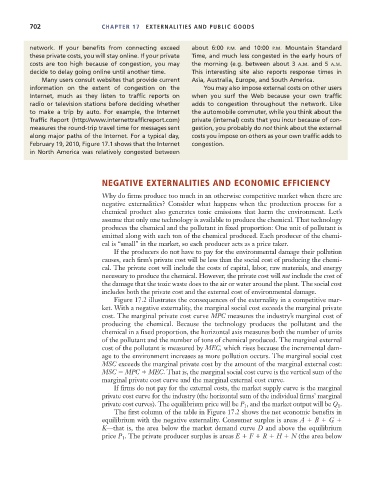Page 728 - Microeconomics, Fourth Edition
P. 728
c17ExternalitiesandPublicGoods.qxd 8/22/10 4:56 AM Page 702
702 CHAPTER 17 EXTERNALITIES AND PUBLIC GOODS
network. If your benefits from connecting exceed about 6:00 P.M. and 10:00 P.M. Mountain Standard
these private costs, you will stay online. If your private Time, and much less congested in the early hours of
costs are too high because of congestion, you may the morning (e.g. between about 3 A.M. and 5 A.M.
decide to delay going online until another time. This interesting site also reports response times in
Many users consult websites that provide current Asia, Australia, Europe, and South America.
information on the extent of congestion on the You may also impose external costs on other users
Internet, much as they listen to traffic reports on when you surf the Web because your own traffic
radio or television stations before deciding whether adds to congestion throughout the network. Like
to make a trip by auto. For example, the Internet the automobile commuter, while you think about the
Traffic Report (http://www.internettrafficreport.com) private (internal) costs that you incur because of con-
measures the round-trip travel time for messages sent gestion, you probably do not think about the external
along major paths of the Internet. For a typical day, costs you impose on others as your own traffic adds to
February 19, 2010, Figure 17.1 shows that the Internet congestion.
in North America was relatively congested between
NEGATIVE EXTERNALITIES AND ECONOMIC EFFICIENCY
Why do firms produce too much in an otherwise competitive market when there are
negative externalities? Consider what happens when the production process for a
chemical product also generates toxic emissions that harm the environment. Let’s
assume that only one technology is available to produce the chemical. That technology
produces the chemical and the pollutant in fixed proportion: One unit of pollutant is
emitted along with each ton of the chemical produced. Each producer of the chemi-
cal is “small” in the market, so each producer acts as a price taker.
If the producers do not have to pay for the environmental damage their pollution
causes, each firm’s private cost will be less than the social cost of producing the chemi-
cal. The private cost will include the costs of capital, labor, raw materials, and energy
necessary to produce the chemical. However, the private cost will not include the cost of
the damage that the toxic waste does to the air or water around the plant. The social cost
includes both the private cost and the external cost of environmental damage.
Figure 17.2 illustrates the consequences of the externality in a competitive mar-
ket. With a negative externality, the marginal social cost exceeds the marginal private
cost. The marginal private cost curve MPC measures the industry’s marginal cost of
producing the chemical. Because the technology produces the pollutant and the
chemical in a fixed proportion, the horizontal axis measures both the number of units
of the pollutant and the number of tons of chemical produced. The marginal external
cost of the pollutant is measured by MEC, which rises because the incremental dam-
age to the environment increases as more pollution occurs. The marginal social cost
MSC exceeds the marginal private cost by the amount of the marginal external cost:
MSC MPC MEC. That is, the marginal social cost curve is the vertical sum of the
marginal private cost curve and the marginal external cost curve.
If firms do not pay for the external costs, the market supply curve is the marginal
private cost curve for the industry (the horizontal sum of the individual firms’ marginal
private cost curves). The equilibrium price will be P , and the market output will be Q .
1
1
The first column of the table in Figure 17.2 shows the net economic benefits in
equilibrium with the negative externality. Consumer surplus is areas A B G
K—that is, the area below the market demand curve D and above the equilibrium
price P . The private producer surplus is areas E F R H N (the area below
1

